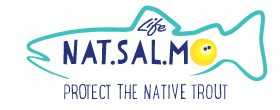Compared to other LIFE projects concerning the Mediterranean trout, LIFE Nat.Sal.Mo introduces innovative techniques.
In particular, the project puts into practice recent methodologies and biotechnologies which, although they have already been successfully tested in other fish species, have never been applied to the Mediterranean trout S. macrostigma.
Selective artificial propagation is currently used in all the programs of recovery and conservation of the different native species of salmonids threatened by genetic introgression: genetically selected individuals are placed on the sites after being bred – even if strictly necessary – in an artificial environment.
The innovative features of the Nat.Sal.Mo Project are:
– restore the genetic integrity of the populations of S. macrostigma by focusing it mainly on the natural reproduction of trout that is not or not introgressed through selective access to the main breeding sites;
– expand the range of S. macrostigma, after having carried out the requalification of the habitat, by means of artificial reproduction with frozen seed of native trouts and fertilization schemes able to maximize the genetic variability of the offspring;
– reduce as much as possible the non-adaptive selective pressure (the hatching and artificial breeding) by implanting the embryonated eggs directly in the sites identified as suitable for repopulating the native trout. The eggs will be sown through the construction of special semi-natural sites, exploiting the natural material present in the riverbed;
-guarantee the involvement of local communities in the project and its continuation over time, in particular by entering into “River Contracts” with fishermen and related associations, ie voluntary agreements to observe good practices and respect the rules to protect species and habitats.
Selective access
It allows to select access to natural spawning sites by allowing only the native breeders with little or no introgression. In the USA, this system is used in Pacific salmon hatcheries to keep the breeding stock released at the young stage by the same plant. At the same time, the wild breeders, that are allowed to reach the reproduction areas, are recognized. The native trout populations of the Biferno and Volturno rivers are characterized by a massive upward migration. Therefore, during this migration, the reproductive specimens will be captured through fixed traps, thus allowing the recognition of introgressed reproducers – to be eradicated – from those less or not at all introgressed, which will be released to continue migration upstream and reproduce naturally. Although this technique is widely used and tested in the management of artificial Pacific salmon breeding facilities, we can consider it as an unusual and innovative system for the eradication of alien species (or introgressed specimens) for the native salmonid populations of the Mediterranean rivers.
Sperm cryopreservation and fertilization protocols
The cryopreservation of gametes is considered an effective method for saving endangered fish species thanks to the creation of genetic banks.
Furthermore, the freezing of the seed has several advantages for the protection of biodiversity in the context of artificial supportive reproductive actions, because with this technique it is possible to minimize inbreeding and selection due to domestication. Currently, in fish farms sperm cryopreservation is the only cryogenic technology available to develop ex situ conservation programs, as the cryopreservation of oocytes and embryos is still unsatisfactory. It must be emphasized that these techniques have never been used before in concrete actions to safeguard S. macrostigma. Simultaneously with the optimization of the cryopreservation techniques of the male gametes of the Molise salmonid populations, an appropriate cross-fertilization protocol will be used in order to safeguard the diversity of natural populations.


